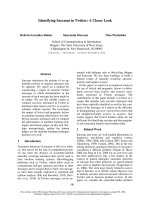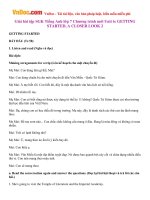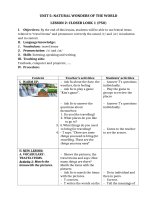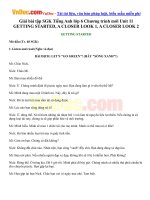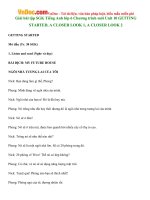Unit 5A closer look 1
Bạn đang xem bản rút gọn của tài liệu. Xem và tải ngay bản đầy đủ của tài liệu tại đây (827.71 KB, 9 trang )
<span class='text_page_counter'>(1)</span>Teacher: Huynh Phong Dinh.
<span class='text_page_counter'>(2)</span> 1. Write the words with the correct pictures. A. cavern. B. limestone. C. fortress. D. tomb. E. citadel. F. sculpture. limestone 1.__________________. tomb 2.__________________. cavern 3.__________________. citadel 4.__________________. fortress 5.__________________. sculpture 6.__________________.
<span class='text_page_counter'>(3)</span> 2. Fill in each blank with a suitable adjective from the box. geological. located/situated picturesque administrative astounding. located/situated in a quiet 1. The hotel is beautifully ______________ spot near the river. picturesque 2. It is a quiet fishing village with a ______________ harbour. 3. The original size of the Forbidden City is _______ astouding _________________ - it's hard to believe. geological 4. This book is about _____________features of Viet Nam. administrative centre of our country. 5. Ha Noi is the ____________.
<span class='text_page_counter'>(4)</span> 3a. Match the nouns in A to the definitions in B. A. 1. setting. B. a. a general word for a building of any kind. 2. complex. b. the place where something is and the general environment around it. 3. structure. c. an acceptance that something exists, is true, or is valuable. 4. measures. d. a group of connected buildings that are designed for a particular purpose. 5. recognition. e. official actions that are done in order to achieve a particular aim.
<span class='text_page_counter'>(5)</span> 3b. Now use the nouns in a to complete the sentences. 1. setting 2. complex. 3. structure. 4. measures 5. recognition. structure 1. This has been standing since the 15th ____________ century. measures 2. The government must take ___________ to preserve historical sites in the area. setting 3. I like a hotel in a beautiful __________ of landscaped gardens. complex 4. The Imperial Citadel of Thang Long is a __________ that consists of royal palaces and monuments. recognition that protecting natural 5. There is a growing__________ wonders has financial benefits as well as cultural importance.
<span class='text_page_counter'>(6)</span> PRONUNCIATION Stress on auxiliary verbs in sentences. 4. Listen and repeat, paying attention to the words in red in each pair of sentences. 1. A: This is a solution, but not the only one. B: Attempts to find a solution have failed. 2. A: I'm fond of bananas. B: Bananas are what I'm fond of. 3. A: It's not trick and treat; it's trick or treat. B: I need Peter and Mary or John and Nick to help me. 4. A: It's good but expensive. B: You shouldn't put 'but' at the end of the sentence..
<span class='text_page_counter'>(7)</span> PRONUNCIATION Stress on auxiliary verbs in sentences. 4. Listen and repeat, paying attention to the words in red in each pair of sentences..
<span class='text_page_counter'>(8)</span> Remember! Short words like articles (a, an, the), conjunctions (and, or), and prepositions (at, of, to) are usually unstressed or in the weak form. However, we use these short words in the strong form in the following cases: When the short words are used at the end of sentences. Example:. What are you playing at? Mary is the person I’m looking for.. When the short words are used for emphasis or contrast. Example:. This is the place to eat. It’s not a solution, but the solution. When the short words are used for citation. Example:. You should put ‘and’ at the end of the sentence..
<span class='text_page_counter'>(9)</span> 5. Read the mini-talks and underline the short words (for, the, from, and, but, at, of, to) you think use the strong form. Then listen and check.. Example: A: Who are you looking for? B: Peter is the person I'm looking for. 1. A: Where are you from? B: I'm from Ha Noi. 2. A: Can you come and check this paragraph for me? B: It's OK but you shouldn't use 'and' at the beginning of the paragraph. 3. A: Did you ask her to join our group? B: I've asked her several times but she doesn't want to. 4. A: Is this letter from Peter? B: No, the letter is to him, not from him..
<span class='text_page_counter'>(10)</span>
